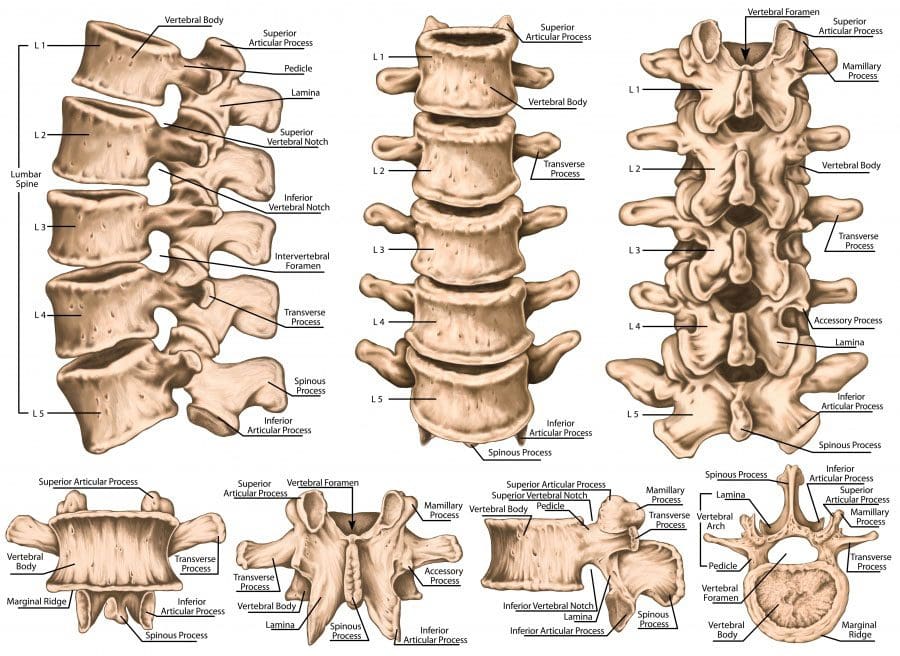Spinal Tumor Type Overview
A spinal tumor is an uncommon cause of back pain. They rarely occur and can be either benign or malignant. Some tumors can metastasize or spread out to other parts of the body. This is done through the arteries, veins, the lymphatic system, and directly depending on the location.
A tumor of the breast, prostate, lung, and kidney can metastasize into the spine increasing the risk of spinal compression. This could lead to neurologic dysfunction and paralysis. Many individuals present with back pain as the key symptom. The pain can worsen at night and have no relation to certain activities. Other symptoms include:
- Sciatica
- Numbness
- Paraparesis – slight paralysis
- Spinal deformity – scoliosis, kyphosis
- Fever

Table of Contents
Benign – Noncancerous
Aneurysmal Bone Cysts
Aneurysmal bone cysts or ABCs usually cause pain and swelling. They can be large and typically affect children and adolescents.
Eosinophilic Granuloma
This type of spinal tumor usually develops in the vertebral bodies of children and adolescents. If the tumor is systemic it is called histiocytosis X. However, these tumors rarely lead to vertebral collapse and paraparesis. And also rarely but on occasion, they can heal spontaneously on their own.

Giant Cell Tumor
This type of spinal tumor affects children, adolescents, and young adults. They can be found around the cervical, thoracic, or lumbar segments of the spine, but are more common in the sacrum region.
Hemangioma
Hemangiomas develop most often in the thoracic or middle back. These affect adults and are known to be vascular masses that are progressive and can cause vertebral collapse and slight paralysis.
Osteoblastoma
These tumors can be large, aggressive, and painful. They affect children and adolescents. They can sometimes cause spinal deformity and paralysis.
Osteochondroma
This a slow-growing spinal tumor that comes from cartilage and usually affects adolescents. It is uncommon and typically found in the posterior or rear of the spine.
Osteoid Osteoma
A very small bone tumor that is less than 2 cm. It typically affects adolescents. It is known to cause night pain and can result in spinal deformity.

Malignant – Cancerous
Chordoma
This is typically seen in adults. About 50% involves the sacrum, but it can affect other regions of the spine. These tumors usually require aggressive treatment.
Chondrosarcoma
This tumor affects the spinal cartilage in middle-aged adults. It grows slowly but can be dangerous. Aggressive medical treatment is required.
Ewing/Ewing’s Sarcoma
An aggressive spinal tumor that affects adolescents and young adults. In certain cases, it can metastasize.
Lymphoma
Lymphoma can present in one or more vertebral bodies. It affects middle-aged and older adults. The lymphatic system can sometimes be involved.
Osteosarcoma
This is a bone cancer that develops in adolescents and middle-aged adults. It can metastasize and require aggressive medical treatment.
Plasmacytoma
Plasmacytoma typically presents in middle-aged and older adults. They usually present in the pedicle and vertebral body and can cause paraparesis.

Back pain does not always mean that there is a tumor present. But if back pain does not resolve or if neurologic symptom/s are experienced, early medical intervention/treatment is definitely warranted. A primary spinal tumor or those that originate in the spine are uncommon. However, metastatic spinal tumors are.
Spinal tumors are not a common cause of back pain, but if there is pain whose cause cannot be identified and continues with no change, it could be an indicator of something more going on. Persistent pain, specifically if it is not brought on with activity or if it worsens at night, could be a potential red flag needing further examination by x-ray, CT, or MRI. Metastatic tumors, that spread from another area such as the lung, breast, colon, and prostate are a more common type of spinal tumor. Individuals with a family history of cancer that develop back pain out of nowhere should be examined to exclude a spinal tumor.
Low Back & Neck Pain Rehabilitation
Dr. Alex Jimenez’s Blog Post Disclaimer
The scope of our information is limited to chiropractic, musculoskeletal, physical medicines, wellness, and sensitive health issues and/or functional medicine articles, topics, and discussions. We use functional health & wellness protocols to treat and support care for injuries or disorders of the musculoskeletal system. Our posts, topics, subjects, and insights cover clinical matters, issues, and topics that relate and support directly or indirectly our clinical scope of practice.*
Our office has made a reasonable attempt to provide supportive citations and has identified the relevant research study or studies supporting our posts. We also make copies of supporting research studies available to the board and or the public upon request. We understand that we cover matters that require an additional explanation as to how it may assist in a particular care plan or treatment protocol; therefore, to further discuss the subject matter above, please feel free to ask Dr. Alex Jimenez or contact us at 915-850-0900. The provider(s) Licensed in Texas& New Mexico*
Post Disclaimer
Professional Scope of Practice *
The information herein on "Spinal Tumor Type Overview" is not intended to replace a one-on-one relationship with a qualified health care professional or licensed physician and is not medical advice. We encourage you to make healthcare decisions based on your research and partnership with a qualified healthcare professional.
Blog Information & Scope Discussions
Welcome to El Paso's Wellness blog, where Dr. Alex Jimenez, DC, FNP-C, a board-certified Family Practice Nurse Practitioner (FNP-C) and Chiropractor (DC), presents insights on how our team is dedicated to holistic healing and personalized care. Our practice aligns with evidence-based treatment protocols inspired by integrative medicine principles, similar to those found on dralexjimenez.com, focusing on restoring health naturally for patients of all ages.
Our areas of chiropractic practice include Wellness & Nutrition, Chronic Pain, Personal Injury, Auto Accident Care, Work Injuries, Back Injury, Low Back Pain, Neck Pain, Migraine Headaches, Sports Injuries, Severe Sciatica, Scoliosis, Complex Herniated Discs, Fibromyalgia, Chronic Pain, Complex Injuries, Stress Management, Functional Medicine Treatments, and in-scope care protocols.
Our information scope is limited to chiropractic, musculoskeletal, physical medicine, wellness, contributing etiological viscerosomatic disturbances within clinical presentations, associated somato-visceral reflex clinical dynamics, subluxation complexes, sensitive health issues, and functional medicine articles, topics, and discussions.
We provide and present clinical collaboration with specialists from various disciplines. Each specialist is governed by their professional scope of practice and their jurisdiction of licensure. We use functional health & wellness protocols to treat and support care for the injuries or disorders of the musculoskeletal system.
Our videos, posts, topics, subjects, and insights cover clinical matters, issues, and topics that relate to and directly or indirectly support our clinical scope of practice.*
Our office has reasonably attempted to provide supportive citations and has identified the relevant research studies or studies supporting our posts. We provide copies of supporting research studies available to regulatory boards and the public upon request.
We understand that we cover matters that require an additional explanation of how they may assist in a particular care plan or treatment protocol; therefore, to discuss the subject matter above further, please feel free to ask Dr. Alex Jimenez, DC, APRN, FNP-BC, or contact us at 915-850-0900.
We are here to help you and your family.
Blessings
Dr. Alex Jimenez DC, MSACP, APRN, FNP-BC*, CCST, IFMCP, CFMP, ATN
email: coach@elpasofunctionalmedicine.com
Licensed as a Doctor of Chiropractic (DC) in Texas & New Mexico*
Texas DC License # TX5807
New Mexico DC License # NM-DC2182
Licensed as a Registered Nurse (RN*) in Texas & Multistate
Texas RN License # 1191402
ANCC FNP-BC: Board Certified Nurse Practitioner*
Compact Status: Multi-State License: Authorized to Practice in 40 States*
Graduate with Honors: ICHS: MSN-FNP (Family Nurse Practitioner Program)
Degree Granted. Master's in Family Practice MSN Diploma (Cum Laude)
Dr. Alex Jimenez, DC, APRN, FNP-BC*, CFMP, IFMCP, ATN, CCST
My Digital Business Card


